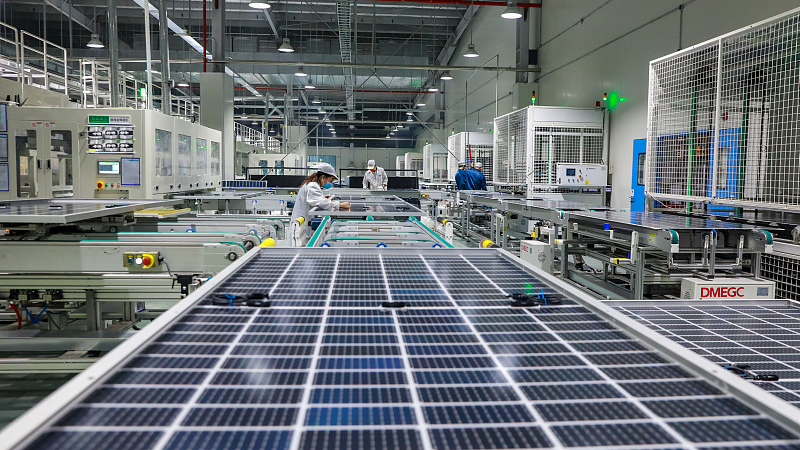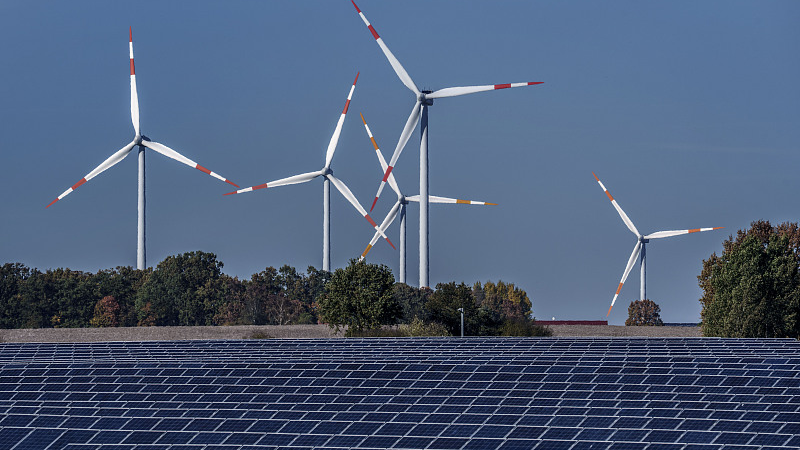
Workers are producing solar cells and modules, Jiangsu, China, April 12, 2022. /CFP
Workers are producing solar cells and modules, Jiangsu, China, April 12, 2022. /CFP
Editor's note: Djoomart Otorbaev is the former prime minister of the Kyrgyz Republic, a distinguished professor of the Belt and Road School of Beijing Normal University, and a member of the Nizami Ganjavi International Center. The article reflects the author's views and not necessarily those of CGTN.
In a previous article, it has been shown that the generation of renewable energy is growing at an unprecedented rate. Still, even that pace is not sufficient to achieve carbon neutrality on the planet by 2060. These days, the most impressive developments are taking place in the solar energy market.
Between 2010 and 2020, the cost of electricity generated by solar photovoltaic (PV) technologies dropped 85 percent. Solar instalments have become the cheapest way to generate electricity, which is the key to accelerated public and private investment in this sector for years to come. Installation costs have also been reduced, driven by improved module efficiency and economies of scale. As a result, the total cost of PV solar energy generation between 2010 and 2021 decreased from $4,808/kW to $857/kW.
Given priority to solar energy development over the past 10 years, China has emerged as the undisputed leader in this direction. Its market share in all critical stages of the production of solar installations has exceeded 80 percent. And for crucial battery elements such as polysilicon and wafers, that proportion will soon rise to more than 95 percent .
To prevent their solar panel companies from going bankrupt, all the leading countries have imposed draconian import duties on Chinese products, placing the burden of additional costs on the end consumer. The duties were introduced by the U.S., EU, UK and India. But these measures did not prove helpful. According to the data from Chinese customs, the exports of China-made solar panels, for example, to the EU grew by 138 percent in the first eight months of 2022 compared to the same period in 2021 .
The unprecedented rise of energy prices worldwide will continue to be for a long time the main factor in the growing demand for renewables. Despite government subsidies making it easier for European households to pay their bills, they are several times higher today than in 2019-2020. The massive growth in sales of solar installations is determined by the fact that solar panels, unlike wind turbines, can be used by millions of ordinary consumers in residential buildings.

Wind turbines turn behind a solar farm in Rapshagen, Germany, October 28, 2021. /CFP
Wind turbines turn behind a solar farm in Rapshagen, Germany, October 28, 2021. /CFP
Enterprises have also increased their interest in using solar panels as they do not receive government subsidies. The shortened payback period for installing solar panels, from 15 years a few years ago to seven years now, when installed on medium-sized rooftops in most Western European countries, makes solar panels much more attractive. Considering that Europe will try to end its dependence on hydrocarbon supplies from Russia, interest in new rooftop solar installations has skyrocketed. Experts forecast the continuation of explosive household growth in installing individual solar panels, and distribution companies have begun to place orders in order to satisfy the increased demand of the markets.
Given the tense situation in their countries due to high inflation and especially rising energy prices, it will be increasingly difficult for the U.S. and European regulators to impose additional import duties on these products. China's competitiveness and dominance in the entire solar energy value chain are so evident that even if someone succeeds in erecting new trade barriers, consumers will still prefer high-quality and price-competitive products. In this case, ordinary citizens will have to bear the new burden of new customs duties that may be introduced. And this could be a politically dangerous move by any government.
Meanwhile, it cannot be argued that the massive use of solar installations worldwide will be problem-free. During the construction of large-scale installations, serious problems will arise with allocating suitable and inexpensive land. The means of accumulating the generated electricity remain expensive. Rising prices for raw materials, especially polysilicon, and discriminatory measures in supply chains have led to an increase in the price of solar panels by about 20 percent in the last year alone. Realizing this, regulators and companies in leading countries prioritized improving the supply chains for producing these systems and optimizing the extraction and enrichment of the necessary components. The International Energy Agency report argues that these problems will require more attention and additional efforts from politicians and regulators shortly.
The countries' political leadership trying to put up barriers to fair competition should realize the futility of their attempts. Their actions to introduce discriminatory measures to restrict imports from third countries will not lead to price optimization and upgrade the final product quality. Fair competition has contributed to the economy's development and humankind's progress. It is no coincidence that all countries introduce regulatory bodies in their jurisdictions that promote competition rather than hinder it. All major players in the market of renewable solar installations should focus not on limiting competition but on technological and industrial cooperation. Achieving carbon neutrality goals by 2060 with joint efforts will be faster and more efficient.
(If you want to contribute and have specific expertise, please contact us at opinions@cgtn.com. Follow @thouse_opinions on Twitter to discover the latest commentaries in the CGTN Opinion Section.)